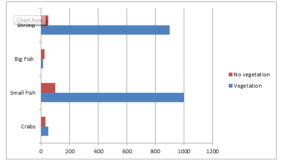Author(s)
Introduction
I have been helping out with an experiment called Squid Pops. It sounds crazy like Popsicle for little kids but in actuality they are a rod with squid attached that is used as bait in the ocean. This research is part of a national study that we are working on with a number of researchers around the world. We want to measure how much predation and abundance within the ocean. To have a healthy ecosystem the ocean needs small fish (prey )and larger fish (predators) to coexist. We need an abundance of small fish to provide food for bigger fish to survive. We place the squid pops out and count how many have been eaten while we capture the different predators with a seine ( net). This helps us measure how many different kinds of predators there are and how big the predators are. It’s very important for children to learn the importance of a healthy ecosystem and how that ecosystem is maintained by predator vs. prey relationships and how humans effect the ocean.
Methods & Procedures
My experience on the Squid Pop project was very procedural. Before we left the lab we collect all the tools that we needed for the day.
Material :
- 4 Buckets
- seine
- ruler that measures in millimeters
- a fish net
- water shoes
- refractometer
- thermometer
We walked to the first site with no vegetation . Before entering the water, we took the salinity using the refractometer in three different places. We also took the temperature of the water in three different places and wrote them down in our data sheet. Then we looked for two poles in the water that were used as a boundary with 25 squid pops that were laid the day before. We used those boundaries and measured 60 meters on the shore that gave us a pathway to where we were going to capture our predators. The outside of the 60 meter we set up the seine then walked out in a straight line about 20 meters. As we made our way back to land, we created a U- Shape so that none of the predators could fall out. Once we got back to land we shook the ends of the seine, working the species to the center.
When gathering the different predators, you have to really know your fish taxonomy and what kinds of fish are located in this region. We first grabbed all the crabs out of the net so that they didn’t feed on any of the other fish. We identified the types of crabs and measured them. To measure a crab you start at one end of the spine (pointy part) to the other end of the spine ( the spines are horizontally located). We then do the same to the fish but we measure from the mouth to the end of the fins. We also found shrimp that we measure from nostrum to tail. We only measure 25 at random and then count the rest. Once we have collected our data we headed to next site. The next site was in a grassy area where we called this the vegetation side and complete the same procedures.
When all of our data is collected we have to clean everything that we used so that our tools last longer and are not producing any bacteria that could be harmful in the water.
Results
Results :
This bar graph shows the data we collected the first day after laying the squid pop’s.
We noticed that on the no vegetation side all the squid pops were eaten due to the amounts of bigger fish that we captured. On the vegetation side about 5 squid pops were not eaten. In this area we found more fish that were mostly small fish. We found that there is a abundance of predation in this area as the numbers grew each day we went out. Once we collected all our data we will send it off and compare it to other findings.
Discussion
I think that the squid pops on the non vegetation site was always eaten because they were out in the open and easily to be eaten by all kinds of predators. As for the vegetation site I think that the Squid Pop’s were harder to be eaten because they were harder to get to due to the grass in the water that created a barrier around them. As they days went on, the squid pops were constantly eaten and we found that as the abundance increased in the oceans we saw an increase of predation.


